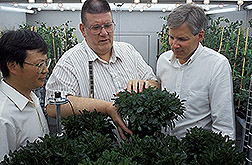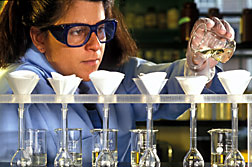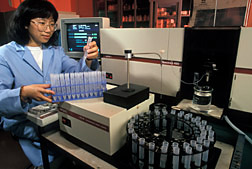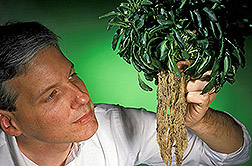Metal-Scavenging Plants to Cleanse the Soil
|
|
Rufus Chaney has his eye on plants with a lusty appetite for toxic heavy metals.
Chaney foresees a day when these remarkable plants will be used to clean contaminated soils at smelter and mining sites, landfills, nuclear waste dumps, farmland, or any urban or rural site contaminated with lead, cadmium, zinc, nickel, or radioactive isotopes such as uranium or cobalt.
The plants would take up the toxic metals or isotopes through their roots and transport them to stems or leaves where they could be easily removed by harvesting.
An Agricultural Research Service agronomist, Chaney says the cost of using plants to clean polluted soil "could be less than one-tenth the price tag for either digging up and trucking the soil to a hazardous waste landfill or making it into concrete."
Chaney, a heavy-metals expert who works at the ARS Environmental Chemistry Laboratory in Beltsville, Maryland, says the cost could be further offset by recovering heavy metals from the plants and selling them. The metal-scavenging plants, called hyperaccumulators, would be grown and harvested like hay, Chaney says. "Burning the hay allows recovery and recycling of the metals. The ash is similar to commercial ore."
Chaney calls the process green remediation. He says that without intervention, heavy metals stay in soil for centuries.
Scott Angle, who collaborates with Chaney at the University of Maryland, says that while the plants researchers are seeking are not currently available, prototype plants are being tested, and the search for hyperaccumulator genes has begun.
Angle is part of Chaney's hyperaccumulator team that also includes graduate student Sally L. Brown, chemist Faye A. Homer, geneticist Yin Li, and technician Carrie E. Green.
Angle is hopeful that plants effective at storing zinc, cadmium, and nickel will become a reality in 5 to 10 years, although he is not as hopeful for plants that take up lead. He says the DuPont Environmental Biotechnology Laboratory is studying removal of lead with selected strains of ragweed.
When it comes to lead removal, ragweed and Thlaspi rotundifolium are better than other plants. But right now, they're too slow, as are the zinc and cadmium hyperaccumulator plants such as Alpine pennycress, Thlaspi caerulescens. Pennycress is a wild herb found on zinc- and nickel-rich soils in many countries.
Historically, hyperaccumulator weeds have been used in Europe by prospectors as signs of the presence of metal ore. The weeds occur in the Alpine areas of Central Europe, as well as in our Rocky Mountains.
"They have spread more widely in Europe and the United States in the past 10,000 years, having survived the glaciers in the Alpine areas. They colonize areas where other plants have died off because of high zinc levels," Chaney says.
"But these plants are usually low-growing, scrawny weeds and take in the metals too slowly to be practical," Angle says.
As a microbiologist, Angle is focusing on improving the plants' rate of metal uptake by removing otherwise beneficial mycorrhizal fungi from their roots. He believes the fungi hinder the plants' ability to take in more metal.
Of the species tested at Pig's Eye Landfill in St. Paul, Minnesota, pennycress was the best at taking in cadmium, zinc, and lead. Pennycress has proven especially good at removing zinc and cadmium, accumulating up to 30,000 parts per million (ppm) of zinc in its leaves without yield reduction. Most plants experience zinc toxicity by the time they reach 500 ppm zinc.
Pennycress can take in zinc at the rate of 125 kilograms per hectare (kg/ha) per year (108 pounds/acre), if fertilized and managed carefully. It takes in cadmium at the rate of 2 kg/ ha per year (1.7 pounds/acre).
"If you have a site with 2,000 kg/ ha zinc, it would typically have 20 to 30 kg/ha cadmium as well. That means the pennycress would take about 16 years to remove both," Chaney says.
A hyperaccumulator bioengineered to be high yielding could take in 500 kg/ha zinc each year and 6 to 8 kg of cadmium. That would reduce the time to about 4 years, making it more practical, Chaney says.
Currently, trials are being held at a town park in Palmerton, Pennsylvania, to test ways to remove zinc and cadmium from soils.
Beverly Kershner, a soil scientist who coordinates and manages the Palmerton site for the Zinc Corporation of America, says the site is thought to have been contaminated by a zinc smelter that operated in Palmerton from 1890 through 1980—before modern environmental regulations existed.
In the Palmerton area, zinc contamination causes serious problems with growing lawns and crops.
Chaney says that the high zinc content of the soil—20,000 kg/ha—interferes with absorption of the accompanying cadmium—about 200-300 kg/ha—by plants. This keeps the amount of cadmium in garden vegetables very low.
|
|
The low levels in edible plants was reflected in blood and urine samples taken from Palmerton residents: Scientists found no signs of cadmium related problems in long-term Palmerton residents, including home gardeners.
Chaney says that there has been concern about toxicity of cadmium because of reports of kidney tubular dysfunction and rickets (osteomalacia) among Japanese farm families eating rice grown on soils contaminated with cadmium from mining and smelting.
There have been no such reports about zinc. And at Palmerton, blood and urine samples showed no signs of zinc toxicity.
"Blood and urine sampling done as part of the Palmerton project suggests that the Japanese situation was a highly unusual case. The rice-based diets and malnourished subsistence of farm families reflects a unique situation of high cadmium intake by people with little or no intake of other minerals that would interfere with cadmium absorption to the blood," Chaney says.
"The Palmerton soil had 50 times as much cadmium as those that produced the rice that affected the Japanese. But most industries that release cadmium also release zinc," he adds, "so the same protective effect would occur."
The most difficult and extensive soil contamination problem for Chaney and other researchers working with hyperaccumulators is lead contamination, says Angle. Both he and Chaney, who is working on other techniques for soil lead remediation, believe that lead is not a metal to begin hyperaccumulator work with. It tends to accumulate in the fibrous roots of plants, making it very difficult to remove by harvesting.
Chaney is engaged in discussions with the U.S. Department of Energy, the U.S. Department of Defense, and the U.S. Environmental Protection Agency to develop hyperaccumulators to clean hazardous and nuclear waste sites, using plant species that accumulate uranium, cesium, strontium, and other radioactive isotopes.
"Plants that accumulate high levels of uranium and cobalt have been found, but no work has been done to maximize this removal," Chaney says.
|
|
Screening for Genes
Li is working with Chaney and Angle to do breeding studies as part of a search for the gene or genes that allow pennycress to hyperaccumulate metals. He says that one way to create the plants he is seeking is to find the responsible gene or genes and insert them into high-yielding plants. The other option is to use traditional breeding to produce Alpine pennycress plants that grow faster and taller.
The varieties Chaney works with currently grow only to 8 to 12 inches.
Alan J.M. Baker of the University of Sheffield in the United Kingdom, who is cooperating with Chaney and Angle in the hyperaccumulator project, has been collecting Thlaspi strains from across Europe. He recently gave Chaney the last of the seeds needed to make genetic crosses of various metal-storing strains of Alpine pennycress.
"You have to cross them to determine the number of genes involved and their characteristics," Chaney says, "before you can search for the genes and try to move them into other plant species."
|
|
Related cooperative research is under way between the ARS Appalachian Soil and Water Conservation Research Laboratory in Beckley, West Virginia, and the Virginia Polytechnic Institute and State University (VPI & SU) in Blacksburg, Virginia.
David C. Martens and Sam Ha of VPI & SU are collaborating with Virupax C. Baligar and Ralph B. Clark of ARS, Xiaoe Yang, from Zhejiang Agricultural University in Hangzhou, China, works at Beckley with Baligar and Clark. She uses a tiny plant called Arabidopsis thaliana to search for hyperaccumulating and excluding plants.
Metal-excluding plants would ensure that at least the edible parts of plants would be free of toxic metals.
Arabidopsis is used as a model plant by molecular biologists because it has a small number of genes and a short life cycle.
From 200,000 seeds that were chemically treated to induce mutations, Yang was able to isolate two plants that were sensitive to nickel toxicity and two that were moderately tolerant to nickel toxicity. The moderately tolerant mutants had smaller and thicker leaves than the wild type.
Currently, Yang's studies are under way to understand the mechanisms responsible for storing or excluding nickel in Arabidopsis. Ha, a molecular geneticist, is using the mutants to find the genes involved.
Yang also tested wheat, corn, cabbage, white clover, and ryegrass for their abilities to store or exclude cadmium, zinc, and nickel. She found that ryegrass accumulated the least amounts of cadmium in its shoots but is an accumulator of nickel. White clover is a nickel excluder.
"Chaney's work has important implications for our efforts to restore the environment," says Don Bills, director of the ARS Natural Resources Institute at Beltsville. "We need new, innovative methods to solve some of our worst pollution problems. The concept of manipulating plant genes that regulate toxic metal uptake is cutting-edge research. This is part of ARS' larger effort to maintain a productive agricultural environment that will sustain American agriculture indefinitely."
— By Don Comis, ARS.
Rufus L. Chaney is with the USDA-ARS Environmental Management and Byproduct Utilization, 10300 Baltimore Avenue, Bldg 007 BARC-West, Beltsville, MD, 20705-2350; (301) 504-8324 ext. 447, fax (301) 504-5048.
Virupax C. Baligar is at the USDA-ARS Sustainable Perennial Crops Laboratory, 10300 Baltimore Avenue, Bldg 001 BARC-West, Beltsville, MD, 20705-2350; phone (301) 504-6492 , fax (301) 504-5823.
"Metal-Scavenging Plants to Cleanse the Soil" was published in the November 1995 issue of Agricultural Research magazine.
Growing Lawns on High-Zinc Soils
Just outside the Borough of Palmerton, Pennsylvania, nestled against Blue Mountain, ARS agronomist Rufus Chaney has test plots that compare the growth of various turf grasses with different soil additives on high-zinc soils. Chaney used his considerable experience with heavy metals and sewage sludge research to tailor the project to local conditions.
He has found that mixing high-iron and high-lime sewage sludge compost into high-zinc soil reduces zinc toxicity to grasses because the soil zinc binds to the compost iron. This decreases zinc uptake by plants.
"Also, the grasses more easily obtain adequate iron, which further reduces their zinc uptake," Chaney says. "Tall fescue varieties did very nicely on soil treated with the sludge compost."
Revival Field—Linking Art and Science
The research and testing of a new "green remediation" technology has advanced from laboratory to field, thanks to an important contribution from an unlikely source—an artist. Green remediation refers to the use of plants to remove heavy metals from contaminated soil.
When New York sculptor Mel Chin read about hyperaccumulator plants, he was struck by the poetic nature of this process. So he conceived a sculpture in which plants and biotechnology would replace chisels and marble. Chin says the aesthetic of "Revival Field," the name for the field trials project, "relates to my interest in alchemy and my understanding of transformative processes and the mutable nature of materials. The contaminated soil is transformed back into rich earth, capable of sustaining a diverse ecosystem."
Chin says his sense of "responsibility to the scientific advancements that could make this change possible" led him to Rufus Chaney, who was doing lab research on hyperaccumulators.
The initial phase of the Revival Field project enabled Chaney's laboratory research to be tested for the first time on actual contaminated sites.
After lengthy and difficult negotiations, Chin was able to secure a location for the first trial at Pig's Eye Landfill in St. Paul, Minnesota. The site is contaminated with cadmium, zinc, and lead. With funding from the National Endowment for the Arts and the Walker Art Center in Minneapolis, this innovative project began.
Following Chaney's scientific plan, Chin designed a circular field with replicated plantings to analyze the use of six hyperaccumulator and metal-tolerant plants and a variety of soil treatments. Two main walkways divided the field like the crosshair of a rifle scope, symbolizing a targeting of the earth for cleanup.
The Minnesota field trial was active from 1990 to 1993. It showed that Alpine pennycress was best at taking in heavy metals, although neither it nor any of the other plants took in metals fast enough to achieve significant cleansing in 3 years.
A second similar test is currently under way near a Superfund site in Palmerton, Pennsylvania. Superfund refers to areas placed on a national priorities list for U.S. Environmental Protection Agency cleanup.
Revival Field is by design a public project, and both collaborators have sought to make information available to a wide audience through lectures, articles, and art exhibitions.
The project has already generated considerable interest among scientists, artists, and environmentally concerned citizens.
Chin says, "The next phase of Revival Field will depend on the needs and directives of Rufus Chaney and a growing body of like-minded specialists from around the world. Art and science will continue their integrated cooperation in an active response to a problem that threatens the health of communities everywhere." — By Don Comis, ARS.











